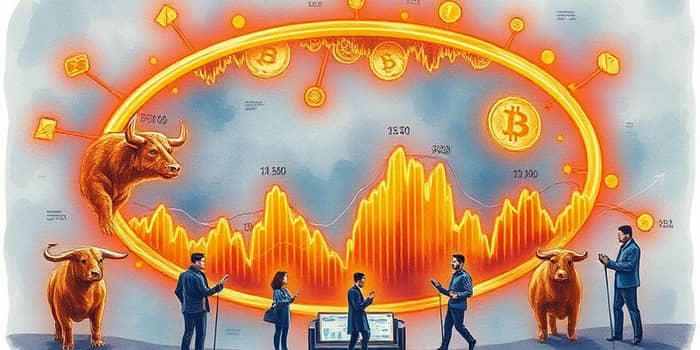Cryptocurrency markets are notorious for their wild price swings and emotional rollercoasters. Yet behind every surge, every crash, lies a structured pattern that has played out for over a decade. By mastering these cycles, investors can transform fear and greed into reliable signals and strategic decision-making tools.
Core Structure of Crypto Market Cycles
All crypto market cycles follow four recognisable stages: accumulation, markup, distribution, and markdown. Each phase exhibits specific price behaviors, market sentiment, and trading patterns. Leaning on historical precedents and on-chain data can illuminate which stage is unfolding.
In the accumulation phase, markets have just experienced a drawdown. Prices are low, volatility subsides, and skepticism is pervasive. This period is marked by maximal risk-reward entry point opportunities for long-term investors who can withstand short-term impatience.
During markup, prices start gaining momentum. Positive news, technical upgrades, and macro tailwinds fuel optimism. Trading volumes rise sharply, and new participants flood in. Indicators such as growth in active addresses and rising network hash rates often confirm strengthening fundamentals.
The distribution stage is where the rally peaks. Price action becomes parabolic, volatility spikes, and media coverage reaches a fever pitch. Greed dominates, and many coins trade at valuations divorced from intrinsic utility. Savvy players begin to take profits, while latecomers chase euphoric highs.
Finally, markdown brings rapid declines. Panic selling and capitulation drive prices down, often by 70–80% from cycle peaks. Social sentiment turns negative, headlines warn of permanent crypto winter, and only the most bullish holders remain. Over time, the market finds a bottom, and the next accumulation phase begins.
Key Influences and Drivers
While the four-stage framework provides a structural roadmap, specific events and trends determine cycle length and amplitude. Recognising these drivers helps investors position themselves ahead of major inflection points.
- Historical four-year halving events reduce new Bitcoin supply and often spark bull markets.
- Global economic and policy shifts such as interest rate hikes, inflation data, and regulatory crackdowns can create sudden volatility.
- Technological breakthroughs and growing adoption fuel optimism, driving in both retail and institutional capital.
- Media-driven hype cycles and sentiment amplify top-of-market euphoria and deepen bottom-of-market despair.
Bitcoin’s halving events in 2012, 2016, 2020, and 2024 correlate strongly with the start of major bull runs. Each reduction cut the block reward in half, tightening supply. Meanwhile, macroeconomic backdrops—ranging from quantitative easing to rising interest rates—have alternately poured liquidity into markets or sapped risk appetite.
Innovation continues to reshape dynamics. The rise of decentralized finance (DeFi) in 2020 and the explosion of non-fungible tokens (NFTs) in 2021 introduced new user segments and capital flows, extending the reach of crypto beyond pure speculation.
Historical Patterns and Data
Since Bitcoin’s inception in 2009, market cycles have averaged around four years, aligning closely with halvings. Although each cycle differs in magnitude, the drawdown depths typically fall between 70% and 80% from peak to trough.
For example, after surging from under $1 to over $1,000 in late 2013, Bitcoin plummeted by approximately 85% before bottoming in early 2015. The 2017 cycle saw a rally to nearly $20,000, followed by an 82% collapse by December 2018.
In the most recent cycle, Bitcoin reached a peak of $69,000 in November 2021 and then declined to $15,476 by November 2022, experiencing 70–80% drawdowns from cycle highs across major cryptocurrencies. These historic swings showcase both the upside potential and the risks inherent in crypto investing.
Despite recurring patterns, cycle timing can shift. Influences such as broader adoption, evolving regulatory frameworks, and the entry of institutional funds can lengthen bull runs or delay recoveries.
Investor Psychology and Behavior
Beyond charts and metrics, market cycles are fundamentally human stories. Cognitive biases and emotional drivers shape rhetoric and trading decisions at every stage.
During accumulation, keen prices before the wider market engages attract experienced investors. Doubt and pessimism shield newcomers, allowing disciplined buyers to build positions with minimal scrutiny.
As price momentum builds, confirmation bias and social proof push novices into the market. Fear of missing out heightens buying frenzies, often leading to rapid overextension. At the distribution stage, euphoria and hubris eclipse caution, and fundamental valuations are secondary to narrative-driven speculation.
Once the markdown phase begins, loss aversion and panic selling dominate. The same individuals who chased highs are now racing to exit. Over time, exhausted sellers give way to contrarian buyers seeking discounted assets, setting the table for the next cycle.
Strategic Implications for Investors
While perfect timing is elusive, a disciplined framework can enhance outcomes. Aligning investment actions with cycle phases and predefined risk parameters helps prevent emotional decisions.
- Accumulate during early accumulation phase for maximal potential long-term gains while volatility remains muted.
- Scale out gradually during markup as price targets are met to lock in profits.
- Transition to defensive assets like stablecoins or hedging positions during the distribution and early markdown stages.
- Employ stop-loss orders and risk limits to guard against catastrophic drawdowns.
Advanced participants often monitor on-chain metrics—such as exchange reserves, active wallet counts, and miner flows—to gauge supply pressure. Sentiment indices, social media trends, and derivatives open interest can add context to price signals.
Finally, portfolio diversification across crypto, traditional assets, and alternative investments can smooth returns and reduce correlation risks.
Cycle Variation and Emerging Trends
Although the classic four-phase cycle holds, new factors are shaping contemporary crypto markets. Institutional involvement, algorithmic trading, and macro correlations to equities have introduced fresh volatility patterns.
Exchange-traded funds (ETFs) and corporate treasury allocations to Bitcoin have widened market participation. As a result, crypto prices have begun to mirror broader risk-on/risk-off dynamics. When equities rally, digital assets often follow suit; conversely, equity sell-offs can drag crypto down further.
Algorithmic market makers and high-frequency trading bots have also increased liquidity but have introduced faster, sharper moves in both directions. Volatility clustering can magnify price swings compared to past cycles.
Lastly, regulatory clarity—or the lack thereof—remains a wildcard. Jurisdictional crackdowns or progressive frameworks can materially accelerate or impede market growth, underscoring the need for continuous vigilance.
Conclusion: Navigating the Crypto Landscape
Mastering market cycles in cryptocurrency is a journey of blending data analysis, psychological insight, and strategic discipline. While past patterns provide a valuable compass, evolving market structures demand adaptability and ongoing learning.
Embrace the cyclical nature of crypto markets as an opportunity rather than a curse. By aligning your strategy with defined stages, managing risk proactively, and avoiding emotional extremes, you can navigate volatility with greater confidence and resilience.
The world of digital assets will continue to innovate and surprise. Armed with a deep understanding of market cycles, you’ll be ready to seize opportunities and withstand challenges in the exciting frontier of cryptocurrency investing.
References
- https://algosone.ai/understanding-different-market-cycles-in-crypto-when-to-buy-hold-and-sell/
- https://onekey.so/blog/ecosystem/understanding-crypto-market-cycles-the-ultimate-guide/
- https://www.northcrypto.com/learn/blog/cryptocurrency-market-cycles
- https://kriptomat.io/finance-investing/predicting-patterns-how-crypto-market-cycles-work/
- https://crypto.com/us/university/four-phases-crypto-market-cycle
- https://finst.com/en/learn/articles/crypto-and-bitcoin-cycles
- https://calebandbrown.com/blog/bitcoins-market-cycle/
- https://flipster.io/en/blog/4-stages-crypto-market-cycle










